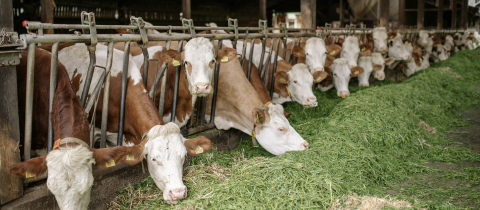I ventured into homemade bread-making at the start of the pandemic two years ago. My first try failed miserably. The bread turned out to be a shapeless, mushy mess. What ingredient was missing? Possibly potassium bromate!
Let’s rewind a bit and talk about flour. Flour turns into a tough mass after kneading with water. That is the result of adjacent molecules of gluten, a type of protein, forming bridges to create a tangled network. These bridges consist of two sulfur atoms and their formation requires a process known as “oxidation.” The slow way to achieve oxidation is to unhurriedly mix flour with water in the presence of oxygen (from the air). The industrial method is fast and efficient and uses potassium bromate, KBrO3 as an oxidizing agent.
But wait, there is a catch! Potassium bromate is a “carcinogen” in other words a substance known to cause cancer. At least in laboratory mice. It is banned in the EU, the UK, Canada, Brazil, India, Japan, and China. But not in the United States. At least not yet. The reasoning is that by the end of the baking process, there is only an infinitesimal amount present in the finished product. But is there really a safe level of exposure? Is there a threshold below which potassium bromate poses no problem? Should US consumers be concerned?
How does a carcinogen cause cancer? It is a long and winding road from exposure to a carcinogen to the genesis of a tumour with multiple factors being involved. It all starts with damage to DNA, the molecule that is commonly referred to as the “blueprint for life.” There are three possible outcomes: (1) Our cellular DNA repair system is able to fix the damage so that the cell can continue to divide and multiply, faithfully reproducing the repaired DNA (2) Our cellular DNA repair system is unable to fix the damage and the cell dies off (thank goodness!); (3) Our repair system fails to fix the DNA error and the error slips through the checkpoints and goes on replicating defective DNA. This alteration in the cell’s genetic material, or “mutation” is the worst-case scenario.
Over time, cumulative gene mutations can lead to uncontrolled cell growth and subsequent formation of a tumour. Mutation can also occur on genes responsible for suppressing tumor growth. A combined mutation involving growth genes and tumor suppressor genes is a double whammy.
But what triggers the very first attack on DNA? Free radicals. These are highly reactive molecular species that have a hunger for electrons. Since electrons are the “glue” holding molecules together, a theft of electrons can result in bond breakage. If free radicals target DNA, genetic damage ensues. Potassium bromate is a source of free radicals collectively known as reactive oxygen species (ROS). When human liver cells grown in a laboratory are treated with potassium bromate, ROS are produced and go on to damage DNA.
The International Agency for Research on Cancer (IARC), an arm of the World Health Organization (WHO) has devoted several decades to sorting possible carcinogens by gauging the following properties: (1) Does the substance have the ability to change DNA structure? (2) Can the substance alter cells? (3) Does the substance cause chronic, long-term inflammation? (4) Is there epidemiological evidence for cancer linked with exposure? Based on these criteria, carcinogens are classified as (1) carcinogenic to humans, (2) probably carcinogenic to humans, or (3) possibly carcinogenic to humans.
Examples of known chemical carcinogens include coal-tar, tobacco smoke, benzene, and asbestos. Ionizing radiation from radioactive materials or from the sun's ultraviolet rays are physical carcinogens, also in category 1. Known viral carcinogens include HPV which causes cervical cancer, hepatitis B & C which causes liver cancer, and the Epstein-Barr virus (EBV) which causes lymphoma.
It is important to point out that extent of exposure is critical. Alcoholic drinks contain ethanol, a known human carcinogen. But this does not mean that an occasional brandy Alexander can result in cancer. Several variables are at play: How much? How long? How often? These all matter.
Now back to potassium bromate in baked goods. As I was starting to draft this article, I received a survey request from an environmental NGO group headquartered in Washington DC. “Would you vote “yes” or “no” for the United States government to ban the use of potassium bromate in bread? My answer would be a definite yes. I remain unconvinced by arguments along the lines of negligible residues of potassium bromate being left in the final product. When it comes to carcinogens, in some cases even trace amounts may be too much. Given that bread can certainly be made without potassium bromate, why take any risk? I’ll take another shot at baking bread the old-fashioned way. After all, the French would not put up with mushy bread and they don’t use any bromates.
The takeaway: Carcinogens are substances that under certain conditions can cause cancer. They should be avoided when possible.
Dr. Nancy Liu-Sullivan holds a Ph.D. in biology and served as a senior research scientist at Memorial Sloan Kettering Cancer Center. She currently teaches biology at the College of Staten Island, City University of New York.








